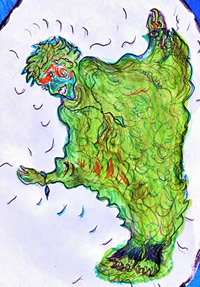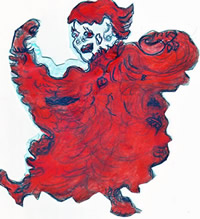Welcome writers –all! If you want to be a writer, these activities are for you.
If you have stumbled across this page and you want to discover something about yourself you didn’t know before, this page is for you.
For class work in schools: these exercises work well across the primary school spectrum. They are all about each young person engaging with the world as he/she sees it and finding words. With its emphasis on observations skills, sensory detail and expression, the activities complement studies in art, music composition and science.
Easily adapted for children in the junior grades and for any students struggling with written language and/or low in motivation.
For teachers and parents: try writing along with children as a shared activity and be surprised at how much fun it can be.
Please view the terms and conditions relating to the content of this website.
Know a Place Through Your Senses
I yelled at him. ‘Gretcho.’
Swish-swish went his tail. I walked towards him happily, the moment of sadness with Nonna forgotten. You could smell summer in the air. A wattlebird flitted past. Then there was nothing but the sound of my footsteps padding on the warm path and the soft hissing of water sprinklers.From page 8.

Alone or with a partner take a walk in your neighbourhood – to your school, the shops, the park or any place that is familiar and a part of your everyday life. Agree not to talk, simply take in the world around you as if this might be the last time you will ever see it in this way again.
- Feel the air on your face – wind, rain, sunlight, snow. How does it feel? What mood is reflected in the day?
- Take in the smell of the air you breathe – dry, dusty, clear, crisp, soft, moist….find words…
- Look at the colours and shapes that catch your eye in the way an artist might.
- Listen for the passing words of people, the sound of traffic, birds, animals, even an insect if that is what attracts your attention.
- Look at the texture of things and find words to describe surfaces – the path, road and grass under your feet – for things natural or made such as a building that attracts you, a lake or the sea.
- Notice the body language of people who pass – the set of their shoulders and the way they walk, run, totter or stride…find words.
As soon as possible sit in a quiet space of your own, hold the images in your mind and write everything you wish to say about the experience in a writer’s notebook or journal. Write about what happened for you – did you notice anything along the way that surprised you? Anything that made you look at something in a different way?
Read over what you have written. Read to somebody – a friend or willing listener.
- Write a poem in free verse or one of the shorter forms of poetry from the one thing you found most interesting, beautiful, astonishing, dull, ugly, funny or sad.
- Imagine being forced to leave this known landscape.
Using your writer’s notes write a narrative on this theme with a beginning, middle and end OR a poem in free verse.
On Pets
Nonna searched my face, as if she wanted to tell me something important. I had asked her about her grand daughter who lived in Rome.
‘Angela is like you,’ she said. ‘Just the same…’
I waited in silence, knowing there was more, but then a wattlebird squawked. Gretcho leapt up and shot across the garden after the bird, woofing and begging, smiling with his wagging tail.
‘No more time for talk,’ Nonna laughed, shaking her head at Gretcho. He already had the lead in his mouth. p.8
Have you ever had a pet? Or do you know somebody who has a pet? Have you a story to share whether happy or sad?
- Write a story from your own experience.
- Write a ‘Wanted’ advertisement for the perfect pet.
- Write a character reference for your pet.
- Write an unsent letter to a pet that might have died unexpectedly or because of old age. If you haven’t experienced the death of a pet, write an unsent letter to Gretcho. Imagine you knew him well, and had played with him. Recall the good times you had together and say goodbye to him. Wish him well in ‘dog’s heaven’.
On Dreams and Signs

Nonna is flying high above her garden. She asks me if I am not well, saying, ‘Tesoro mio stai bene?’
I call to her, ‘Nonna, you can fly. You’ll know what happened to me. You’ll know about my heavy feet.’ p. 19.
If you forget your dreams and can’t recall a dream but would like to try this exercise, for three nights in a row, say to yourself just as you are nodding off to sleep, ‘Dreaming self Dream.’ Say it several times so that it sticks in your mind. This hardly ever fails to produce a dream.
Keep your writer’s notebook close to your bed and write down your dream as soon as you wake up. Write in present tense as if happening right now. E.g. I am…
In class or for fun or because you want to: Choose one dream that is most vivid and write it out more fully – as you remember it. If in colour describe the colours. Describe the objects and people in the dream. Describe yourself and how the dream made you feel.
Write a story with beginning, middle and end based on the dream, but change the dream to a more satisfactory ending. If it is a dream that scares you, change it so that you overcome what ever it is that is worrying or hurting you. Make it into a rounded story. Write this version in the past tense.
Discover the Magic of Leaves
Suzie and I were on our way to school. I saw a leaf floating down from a gum tree and I cried out, ‘Wait!’ I picked up the leaf which lay so quietly on the footpath and examined every little vein. Its colour changed from green to yellow and then to brown at the tips.
‘Are you coming or not?’ Suzie asked.
‘Hang on a minute. Remember what they said on that science show the other night? Leaves make their food from the sun.’
‘So?’
‘So you would never guess just by looking at one.’
The leaf had a secret life like I did. To me it was awesome…But not to Suzie. From p21Discover the magic of trees and their leaves. With a class or group of writing friends:
- Look for and find different kinds of trees.
- Try photographing the leafy canopy of a tree against the sky for a lovely effect.
- Look for birds and animals finding shelter in trees, feeding on blossom or nesting.
- Take photographs of leaves or do drawings. Collect fallen leaves for a collage.
- Choose a leaf and find words that describe – colour, shape, size, texture, smell and if edible, taste.
A metaphor
What does the leaf mean to you? What does the leaf remind you of? Is it a star, a boat, a half moon or something else? Think of shape, colour, texture, smell, taste if edible. Find a likeness to something imagined that means something to you.
Listen for the different sounds made by the wind in trees with different shaped leaves – try sheoak, fir, gum tree, oak, palms, fig.
Find words for the different sounds.
- Write a poem.
- Compose a song.
- Make music with different instruments.
- Write a story about an animal or bird that relies on trees for its existence or write about a tree that is special to you.
Was Celia right in saying the leaves made their food from the sun?
In your writer’s notebook – Explain more clearly. Draw diagrams.
Research the science of leaves – find books and websites that will explain or ask your science teacher.
Conduct experiments – try growing a sweet potato or cuttings that will grow in water in light and then try growing in total darkness. What happens?
Write a report of your findings to Dr McQuade, with a brief letter explaining what it is about.